Management Accounting Case Study Report: ACCT6004 Analysis & Findings
VerifiedAdded on 2022/09/15
|9
|1243
|28
Case Study
AI Summary
This case study analyzes a company's decision to install a new machine, focusing on management accounting techniques. The report calculates overhead rates, assesses the impact of the new machine on labor hours, and evaluates the costs associated with a new job order. The analysis reveals an increase in the overhead rate due to additional costs, affecting the profitability of jobs and highlighting the importance of accurate cost estimation. The conclusion recommends reconsidering the machine installation decision based on the negative financial implications. The references include academic sources that support the analysis and findings presented in the case study. The case study involves calculations and evaluations of management accounting concepts and techniques.
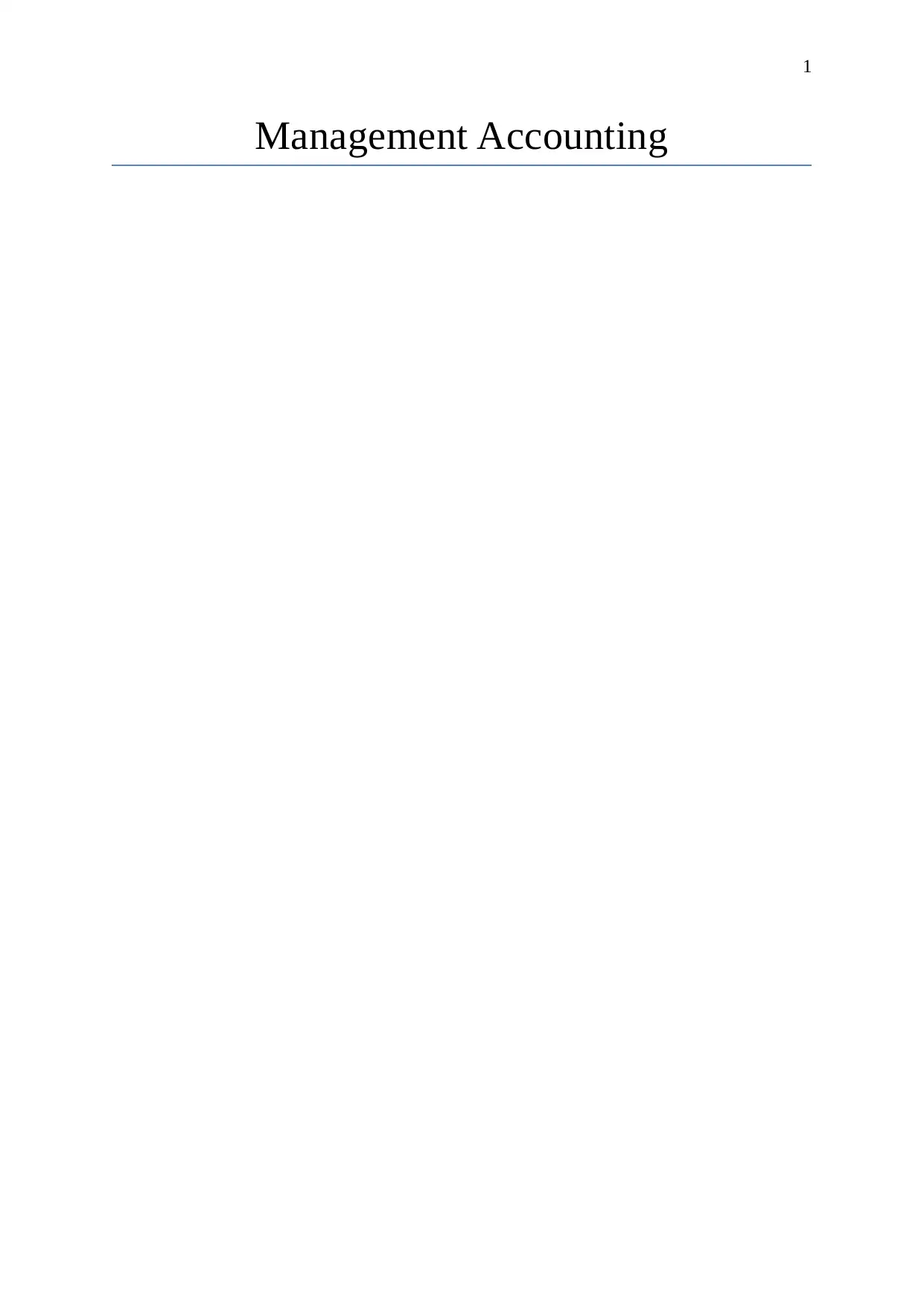
1
Management Accounting
Management Accounting
Paraphrase This Document
Need a fresh take? Get an instant paraphrase of this document with our AI Paraphraser
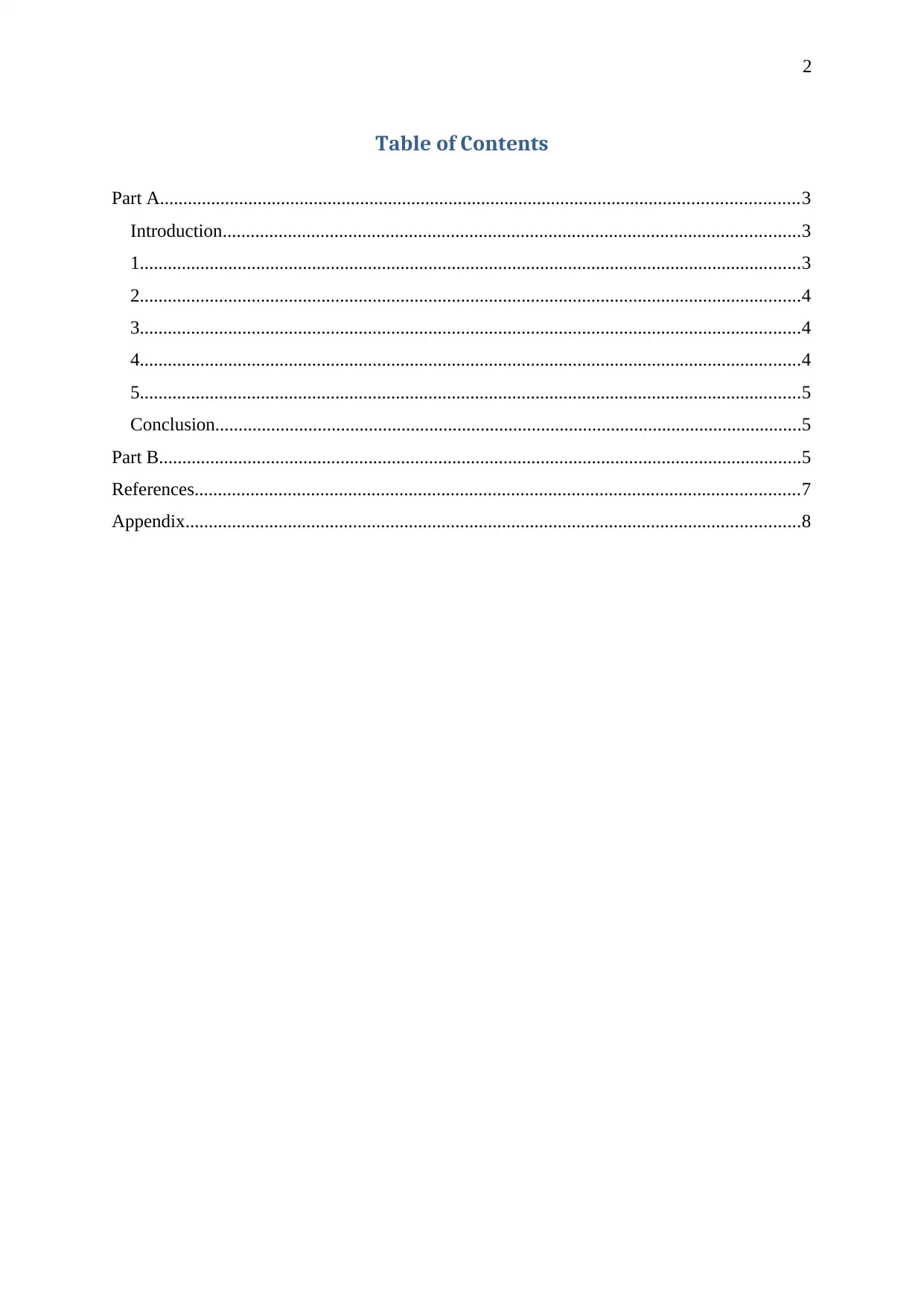
2
Table of Contents
Part A.........................................................................................................................................3
Introduction............................................................................................................................3
1..............................................................................................................................................3
2..............................................................................................................................................4
3..............................................................................................................................................4
4..............................................................................................................................................4
5..............................................................................................................................................5
Conclusion..............................................................................................................................5
Part B..........................................................................................................................................5
References..................................................................................................................................7
Appendix....................................................................................................................................8
Table of Contents
Part A.........................................................................................................................................3
Introduction............................................................................................................................3
1..............................................................................................................................................3
2..............................................................................................................................................4
3..............................................................................................................................................4
4..............................................................................................................................................4
5..............................................................................................................................................5
Conclusion..............................................................................................................................5
Part B..........................................................................................................................................5
References..................................................................................................................................7
Appendix....................................................................................................................................8
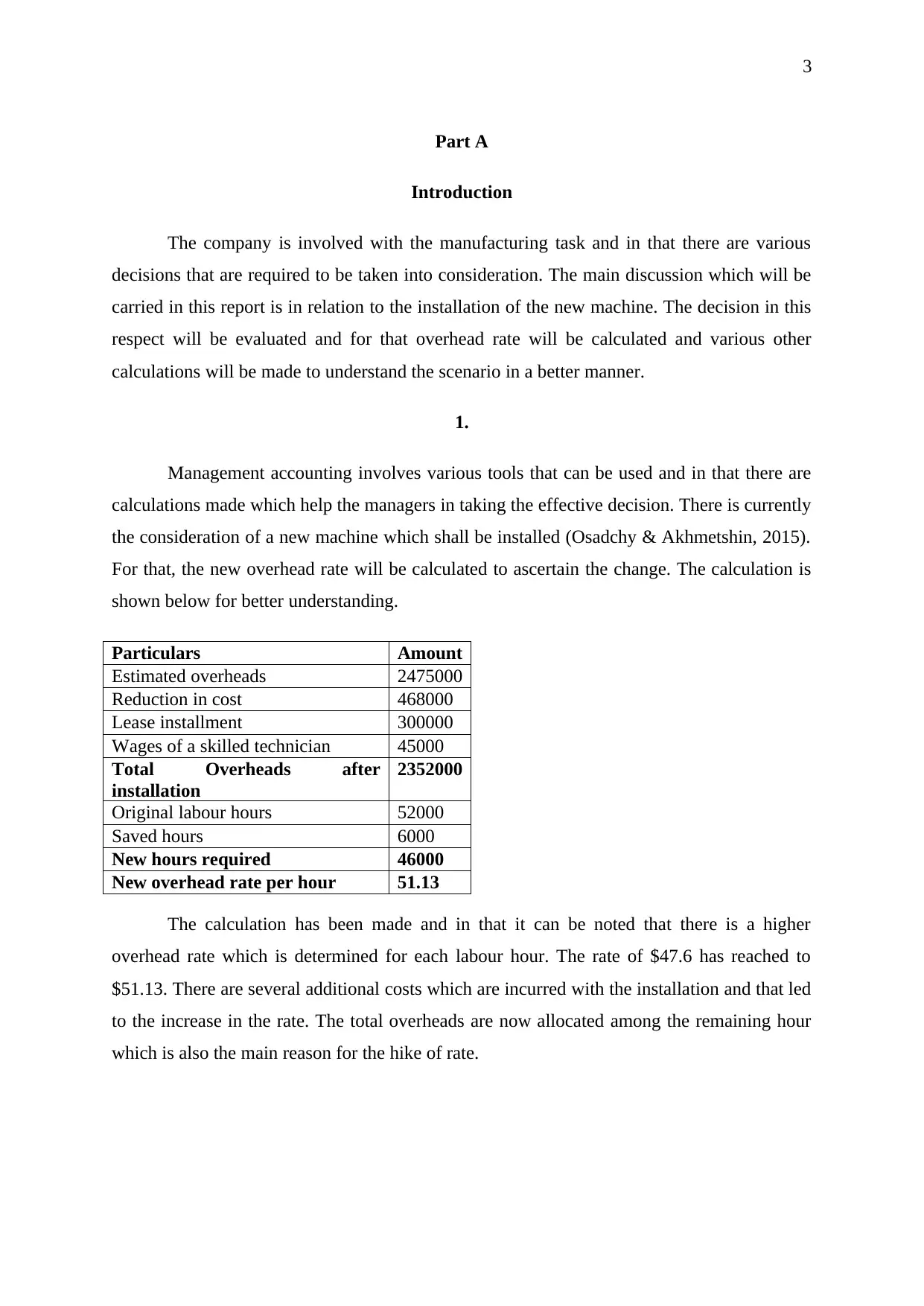
3
Part A
Introduction
The company is involved with the manufacturing task and in that there are various
decisions that are required to be taken into consideration. The main discussion which will be
carried in this report is in relation to the installation of the new machine. The decision in this
respect will be evaluated and for that overhead rate will be calculated and various other
calculations will be made to understand the scenario in a better manner.
1.
Management accounting involves various tools that can be used and in that there are
calculations made which help the managers in taking the effective decision. There is currently
the consideration of a new machine which shall be installed (Osadchy & Akhmetshin, 2015).
For that, the new overhead rate will be calculated to ascertain the change. The calculation is
shown below for better understanding.
Particulars Amount
Estimated overheads 2475000
Reduction in cost 468000
Lease installment 300000
Wages of a skilled technician 45000
Total Overheads after
installation
2352000
Original labour hours 52000
Saved hours 6000
New hours required 46000
New overhead rate per hour 51.13
The calculation has been made and in that it can be noted that there is a higher
overhead rate which is determined for each labour hour. The rate of $47.6 has reached to
$51.13. There are several additional costs which are incurred with the installation and that led
to the increase in the rate. The total overheads are now allocated among the remaining hour
which is also the main reason for the hike of rate.
Part A
Introduction
The company is involved with the manufacturing task and in that there are various
decisions that are required to be taken into consideration. The main discussion which will be
carried in this report is in relation to the installation of the new machine. The decision in this
respect will be evaluated and for that overhead rate will be calculated and various other
calculations will be made to understand the scenario in a better manner.
1.
Management accounting involves various tools that can be used and in that there are
calculations made which help the managers in taking the effective decision. There is currently
the consideration of a new machine which shall be installed (Osadchy & Akhmetshin, 2015).
For that, the new overhead rate will be calculated to ascertain the change. The calculation is
shown below for better understanding.
Particulars Amount
Estimated overheads 2475000
Reduction in cost 468000
Lease installment 300000
Wages of a skilled technician 45000
Total Overheads after
installation
2352000
Original labour hours 52000
Saved hours 6000
New hours required 46000
New overhead rate per hour 51.13
The calculation has been made and in that it can be noted that there is a higher
overhead rate which is determined for each labour hour. The rate of $47.6 has reached to
$51.13. There are several additional costs which are incurred with the installation and that led
to the increase in the rate. The total overheads are now allocated among the remaining hour
which is also the main reason for the hike of rate.
⊘ This is a preview!⊘
Do you want full access?
Subscribe today to unlock all pages.

Trusted by 1+ million students worldwide
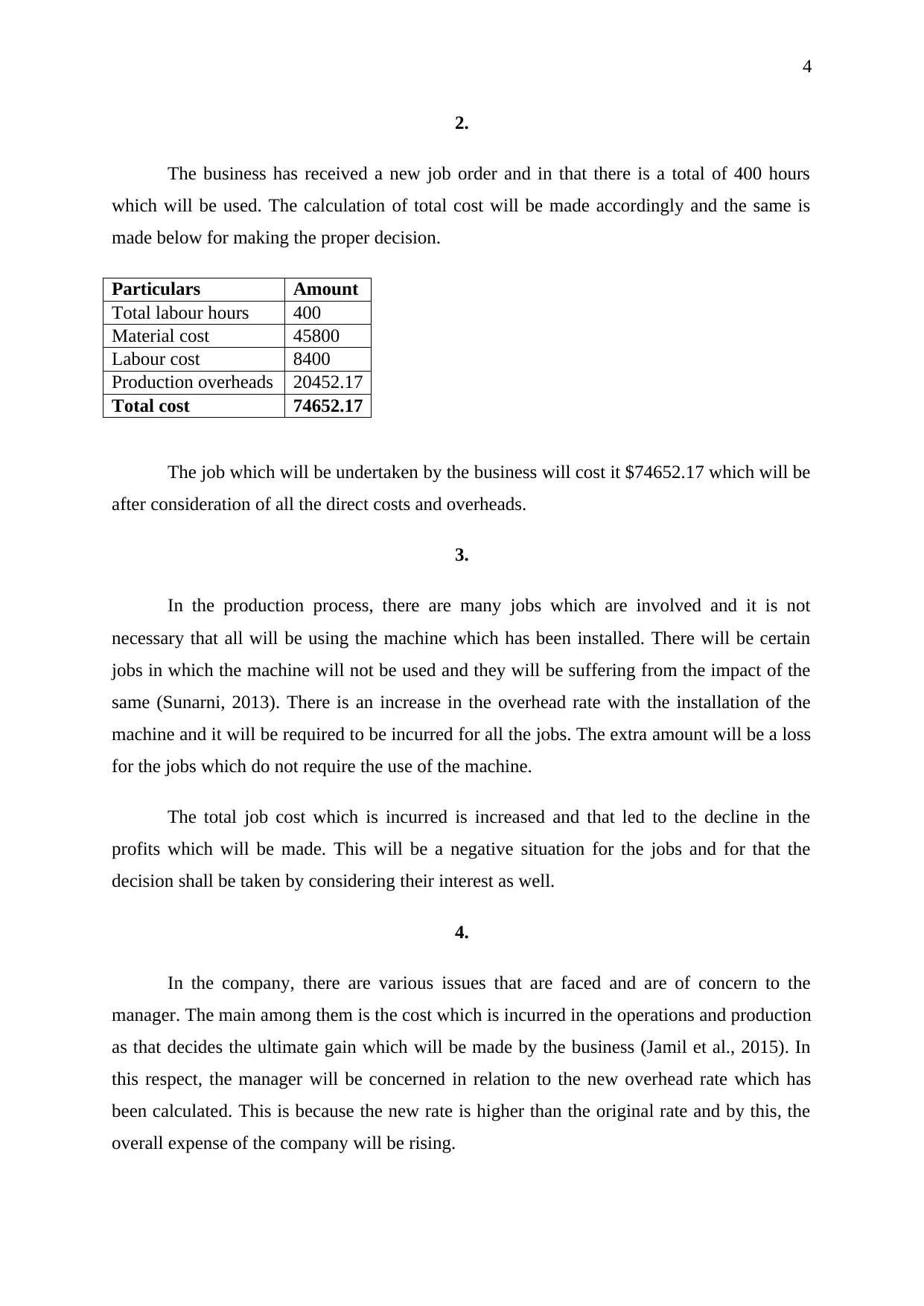
4
2.
The business has received a new job order and in that there is a total of 400 hours
which will be used. The calculation of total cost will be made accordingly and the same is
made below for making the proper decision.
Particulars Amount
Total labour hours 400
Material cost 45800
Labour cost 8400
Production overheads 20452.17
Total cost 74652.17
The job which will be undertaken by the business will cost it $74652.17 which will be
after consideration of all the direct costs and overheads.
3.
In the production process, there are many jobs which are involved and it is not
necessary that all will be using the machine which has been installed. There will be certain
jobs in which the machine will not be used and they will be suffering from the impact of the
same (Sunarni, 2013). There is an increase in the overhead rate with the installation of the
machine and it will be required to be incurred for all the jobs. The extra amount will be a loss
for the jobs which do not require the use of the machine.
The total job cost which is incurred is increased and that led to the decline in the
profits which will be made. This will be a negative situation for the jobs and for that the
decision shall be taken by considering their interest as well.
4.
In the company, there are various issues that are faced and are of concern to the
manager. The main among them is the cost which is incurred in the operations and production
as that decides the ultimate gain which will be made by the business (Jamil et al., 2015). In
this respect, the manager will be concerned in relation to the new overhead rate which has
been calculated. This is because the new rate is higher than the original rate and by this, the
overall expense of the company will be rising.
2.
The business has received a new job order and in that there is a total of 400 hours
which will be used. The calculation of total cost will be made accordingly and the same is
made below for making the proper decision.
Particulars Amount
Total labour hours 400
Material cost 45800
Labour cost 8400
Production overheads 20452.17
Total cost 74652.17
The job which will be undertaken by the business will cost it $74652.17 which will be
after consideration of all the direct costs and overheads.
3.
In the production process, there are many jobs which are involved and it is not
necessary that all will be using the machine which has been installed. There will be certain
jobs in which the machine will not be used and they will be suffering from the impact of the
same (Sunarni, 2013). There is an increase in the overhead rate with the installation of the
machine and it will be required to be incurred for all the jobs. The extra amount will be a loss
for the jobs which do not require the use of the machine.
The total job cost which is incurred is increased and that led to the decline in the
profits which will be made. This will be a negative situation for the jobs and for that the
decision shall be taken by considering their interest as well.
4.
In the company, there are various issues that are faced and are of concern to the
manager. The main among them is the cost which is incurred in the operations and production
as that decides the ultimate gain which will be made by the business (Jamil et al., 2015). In
this respect, the manager will be concerned in relation to the new overhead rate which has
been calculated. This is because the new rate is higher than the original rate and by this, the
overall expense of the company will be rising.
Paraphrase This Document
Need a fresh take? Get an instant paraphrase of this document with our AI Paraphraser
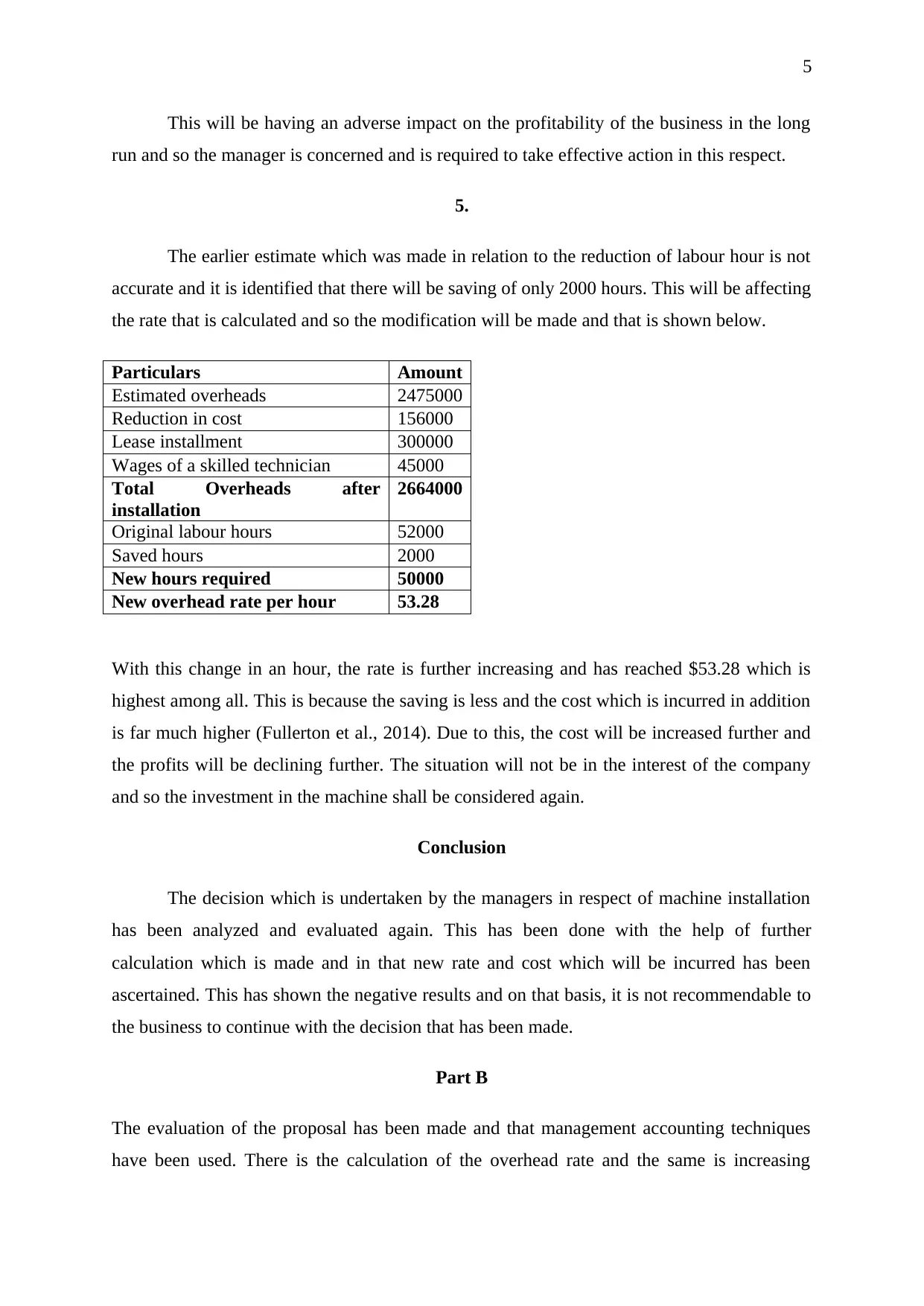
5
This will be having an adverse impact on the profitability of the business in the long
run and so the manager is concerned and is required to take effective action in this respect.
5.
The earlier estimate which was made in relation to the reduction of labour hour is not
accurate and it is identified that there will be saving of only 2000 hours. This will be affecting
the rate that is calculated and so the modification will be made and that is shown below.
Particulars Amount
Estimated overheads 2475000
Reduction in cost 156000
Lease installment 300000
Wages of a skilled technician 45000
Total Overheads after
installation
2664000
Original labour hours 52000
Saved hours 2000
New hours required 50000
New overhead rate per hour 53.28
With this change in an hour, the rate is further increasing and has reached $53.28 which is
highest among all. This is because the saving is less and the cost which is incurred in addition
is far much higher (Fullerton et al., 2014). Due to this, the cost will be increased further and
the profits will be declining further. The situation will not be in the interest of the company
and so the investment in the machine shall be considered again.
Conclusion
The decision which is undertaken by the managers in respect of machine installation
has been analyzed and evaluated again. This has been done with the help of further
calculation which is made and in that new rate and cost which will be incurred has been
ascertained. This has shown the negative results and on that basis, it is not recommendable to
the business to continue with the decision that has been made.
Part B
The evaluation of the proposal has been made and that management accounting techniques
have been used. There is the calculation of the overhead rate and the same is increasing
This will be having an adverse impact on the profitability of the business in the long
run and so the manager is concerned and is required to take effective action in this respect.
5.
The earlier estimate which was made in relation to the reduction of labour hour is not
accurate and it is identified that there will be saving of only 2000 hours. This will be affecting
the rate that is calculated and so the modification will be made and that is shown below.
Particulars Amount
Estimated overheads 2475000
Reduction in cost 156000
Lease installment 300000
Wages of a skilled technician 45000
Total Overheads after
installation
2664000
Original labour hours 52000
Saved hours 2000
New hours required 50000
New overhead rate per hour 53.28
With this change in an hour, the rate is further increasing and has reached $53.28 which is
highest among all. This is because the saving is less and the cost which is incurred in addition
is far much higher (Fullerton et al., 2014). Due to this, the cost will be increased further and
the profits will be declining further. The situation will not be in the interest of the company
and so the investment in the machine shall be considered again.
Conclusion
The decision which is undertaken by the managers in respect of machine installation
has been analyzed and evaluated again. This has been done with the help of further
calculation which is made and in that new rate and cost which will be incurred has been
ascertained. This has shown the negative results and on that basis, it is not recommendable to
the business to continue with the decision that has been made.
Part B
The evaluation of the proposal has been made and that management accounting techniques
have been used. There is the calculation of the overhead rate and the same is increasing
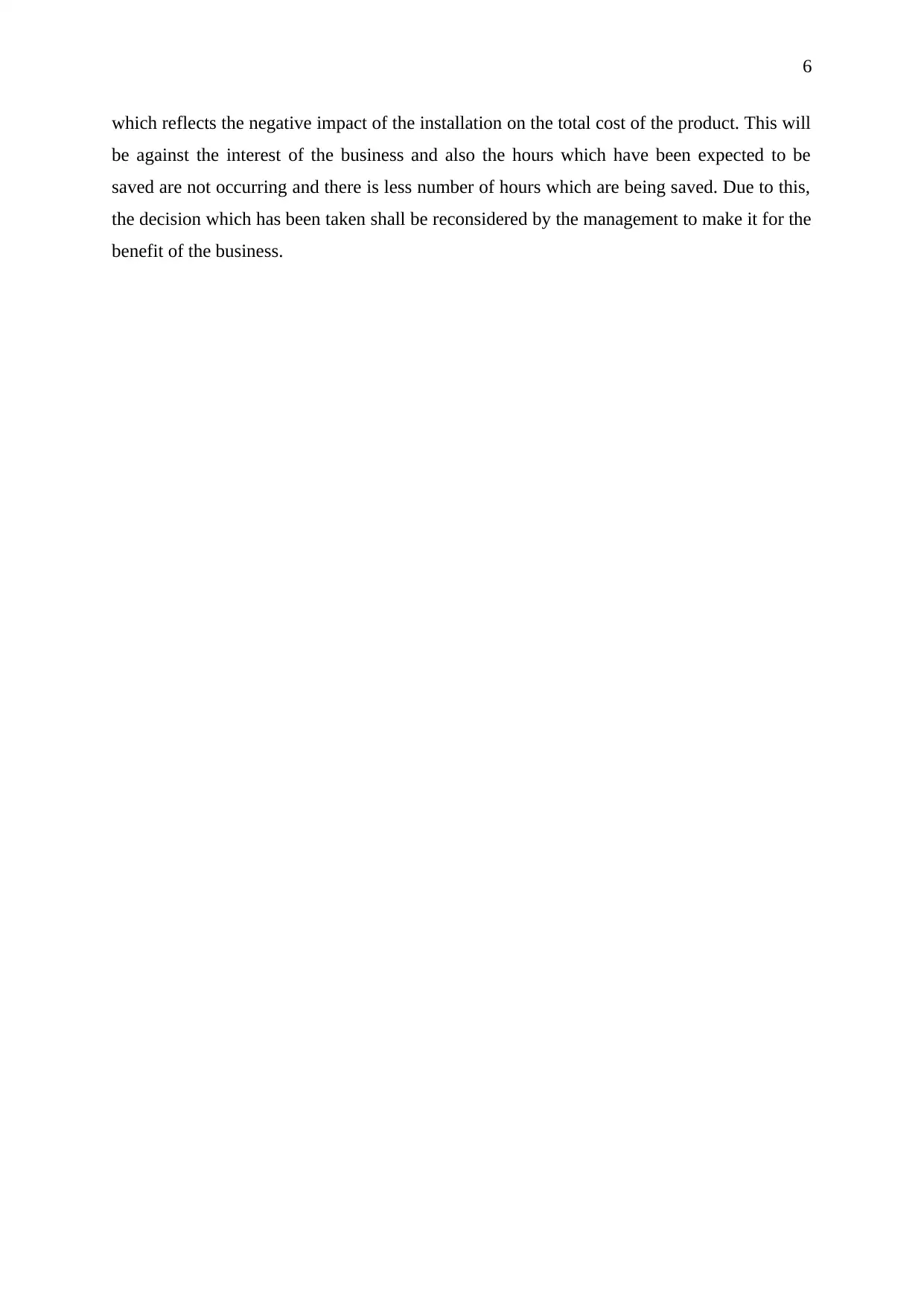
6
which reflects the negative impact of the installation on the total cost of the product. This will
be against the interest of the business and also the hours which have been expected to be
saved are not occurring and there is less number of hours which are being saved. Due to this,
the decision which has been taken shall be reconsidered by the management to make it for the
benefit of the business.
which reflects the negative impact of the installation on the total cost of the product. This will
be against the interest of the business and also the hours which have been expected to be
saved are not occurring and there is less number of hours which are being saved. Due to this,
the decision which has been taken shall be reconsidered by the management to make it for the
benefit of the business.
⊘ This is a preview!⊘
Do you want full access?
Subscribe today to unlock all pages.

Trusted by 1+ million students worldwide
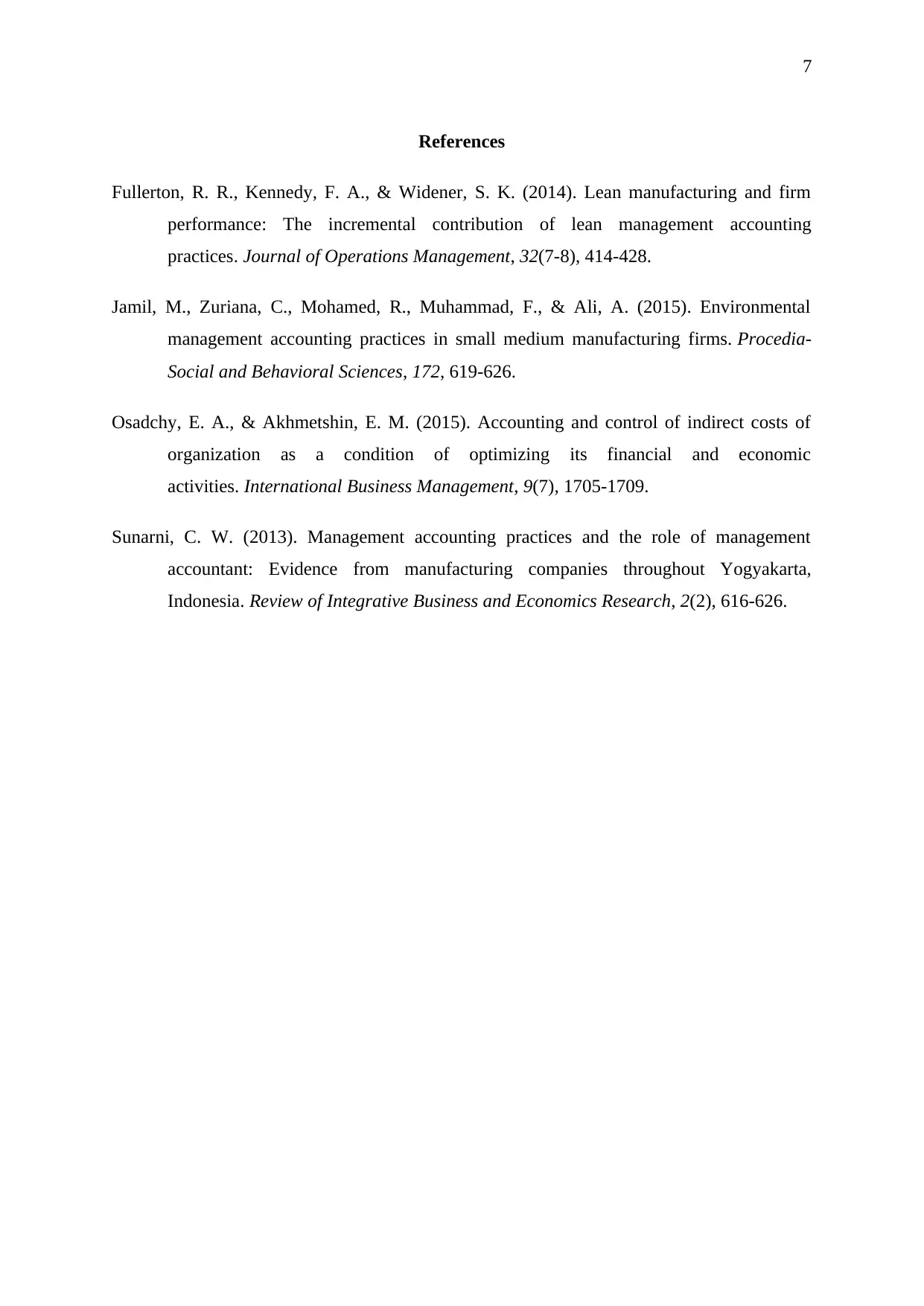
7
References
Fullerton, R. R., Kennedy, F. A., & Widener, S. K. (2014). Lean manufacturing and firm
performance: The incremental contribution of lean management accounting
practices. Journal of Operations Management, 32(7-8), 414-428.
Jamil, M., Zuriana, C., Mohamed, R., Muhammad, F., & Ali, A. (2015). Environmental
management accounting practices in small medium manufacturing firms. Procedia-
Social and Behavioral Sciences, 172, 619-626.
Osadchy, E. A., & Akhmetshin, E. M. (2015). Accounting and control of indirect costs of
organization as a condition of optimizing its financial and economic
activities. International Business Management, 9(7), 1705-1709.
Sunarni, C. W. (2013). Management accounting practices and the role of management
accountant: Evidence from manufacturing companies throughout Yogyakarta,
Indonesia. Review of Integrative Business and Economics Research, 2(2), 616-626.
References
Fullerton, R. R., Kennedy, F. A., & Widener, S. K. (2014). Lean manufacturing and firm
performance: The incremental contribution of lean management accounting
practices. Journal of Operations Management, 32(7-8), 414-428.
Jamil, M., Zuriana, C., Mohamed, R., Muhammad, F., & Ali, A. (2015). Environmental
management accounting practices in small medium manufacturing firms. Procedia-
Social and Behavioral Sciences, 172, 619-626.
Osadchy, E. A., & Akhmetshin, E. M. (2015). Accounting and control of indirect costs of
organization as a condition of optimizing its financial and economic
activities. International Business Management, 9(7), 1705-1709.
Sunarni, C. W. (2013). Management accounting practices and the role of management
accountant: Evidence from manufacturing companies throughout Yogyakarta,
Indonesia. Review of Integrative Business and Economics Research, 2(2), 616-626.
Paraphrase This Document
Need a fresh take? Get an instant paraphrase of this document with our AI Paraphraser
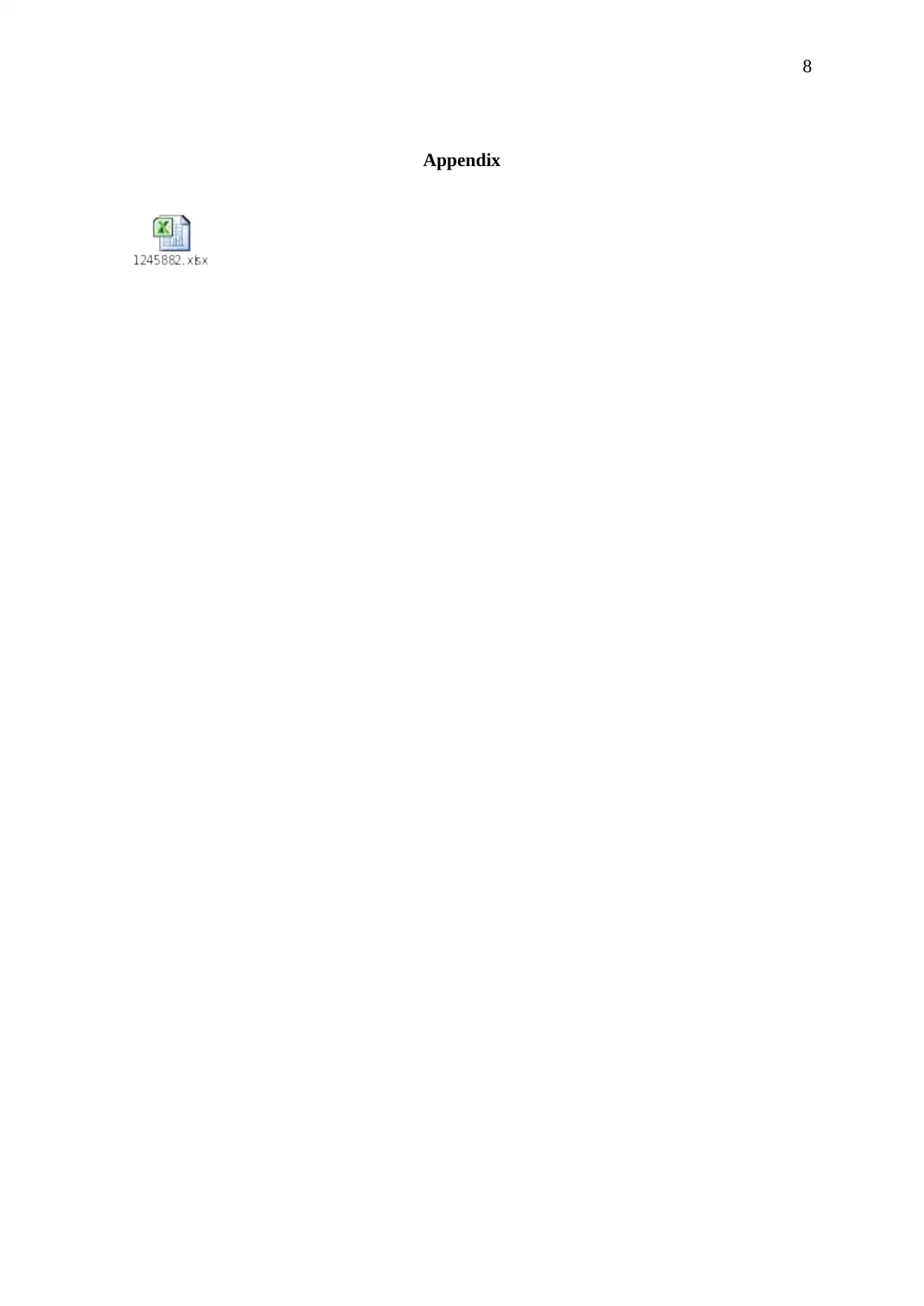
8
Appendix
Appendix

9
⊘ This is a preview!⊘
Do you want full access?
Subscribe today to unlock all pages.

Trusted by 1+ million students worldwide
1 out of 9
Related Documents
Your All-in-One AI-Powered Toolkit for Academic Success.
+13062052269
info@desklib.com
Available 24*7 on WhatsApp / Email
![[object Object]](/_next/static/media/star-bottom.7253800d.svg)
Unlock your academic potential
Copyright © 2020–2025 A2Z Services. All Rights Reserved. Developed and managed by ZUCOL.





